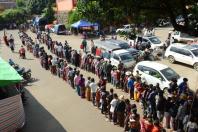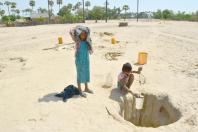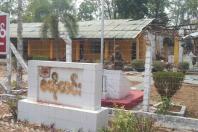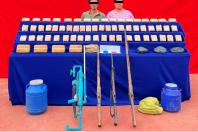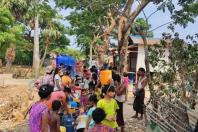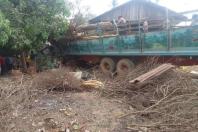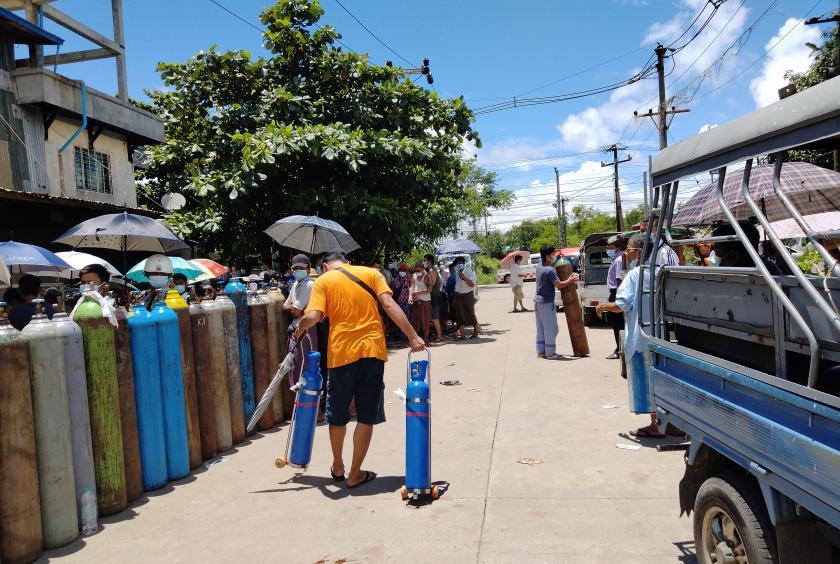
Myanmar has been struck by a deadly third wave of Covid-19 in July. As the disease has spread across the crisis-torn nation, people scramble desperately to deal with widespread oxygen shortages.
High infection rate
The third wave is undeniably more terrible than its second iteration.
The Ministry of Health and Information (MOHS) had said in its reports that laboratory tests of Covid-19 positive cases show the presence of Alpha, Delta and Kappa variants.
The MOHS had said that Delta, even in comparsion against another mutant variant Alpha, is 60 percent more infectious, especially within the family that will usually be in close contact with the infected.
The number of new Covid-19 cases found daily also spiked starting around June, with almost everyday since seeing record breaking numbers of new cases and infection rate.
It started out at a rate of 5.37 percent on May 27 and ramping up quickly to 19.9 percent infection rate on June 30.
By July 9, it was already at 27.4 percent. With scores dying everyday, the amount of deaths since the outbreak is now at 351 people.
Vaccination progress
Myanmar currently has seen vaccination of two out of eight vaccine variants that the WHO had approved for emergency usage; India-made Covishield and Chinese-made Sinopharm.
The MOHS had said that India, due to its own rising cases of Covid-19, cannot supply the remainder of vaccines already purchased and vaccines from China is set to arrive but only in limited numbers of 300,000, which will only be enough for 150,000 people as it is a double-dose.
As per data from the health ministry, there are over 1.4 million people that had recieved both doses of Covishield and 1.8 million that had recieved only once.
According to Dr Khin Khin Gyi, an authority from the MOHS, the government is attempting to purchase 2 million doses of Russian-made Sputnik vaccine and that there is a plan to purchase up to 7 million more.
More townships placed put under stay-at-home order
The stay-at-home orders began to be issued at around end of May and had increased since then at a total of over 30 townships across the country put under the stay-at-home order.
The townships placed under the order until the June 10th, a date many expect to be extended much further, are the following; Chanmyae Tharzi, Aungmyay Tharzan, Chanaye Tharzan, Pyigyi Tagon, Maha Aung Myay and Pathein Gyi, Pyin Oo Lwin and Amarapura from Mandalay Region, Tharyawaddy, Minhla, Letpaden and Phyu in Bago Region, Tonzam, Tiddim, Phalam, Htantalan and Hakha in Chin State, Tamu and Homalin in Sagaing Region, Lashio, Naung Cho, Laukkai in Shan State, Pathein, Myaungmya and Tharpaung in Ayeyawaddy Region.
The plan of the MOHS and the Covid-19 control committee is to restrict movement from townships that were deemed viral hotspots into other, safer areas. A quarantine of 10 days will be imposed on those coming from stay-at-home townships if test results show to be negative, following extant procedures if they tested positive.
While those not from stay-at-home townships do not need to undergo quarantine, emergency restrictions may be imposed according to the situation, even for those that had already had their vaccinations..
Hmawbi, Mingalardon, Shwepyithar, Hlaingtharyar, Insein, North and South Oakkalapa, Mingalar Taungnyunt, Bahan Township and Mayangone townships, all from Yangon Region, were all recently added to the stay-at-home programs.
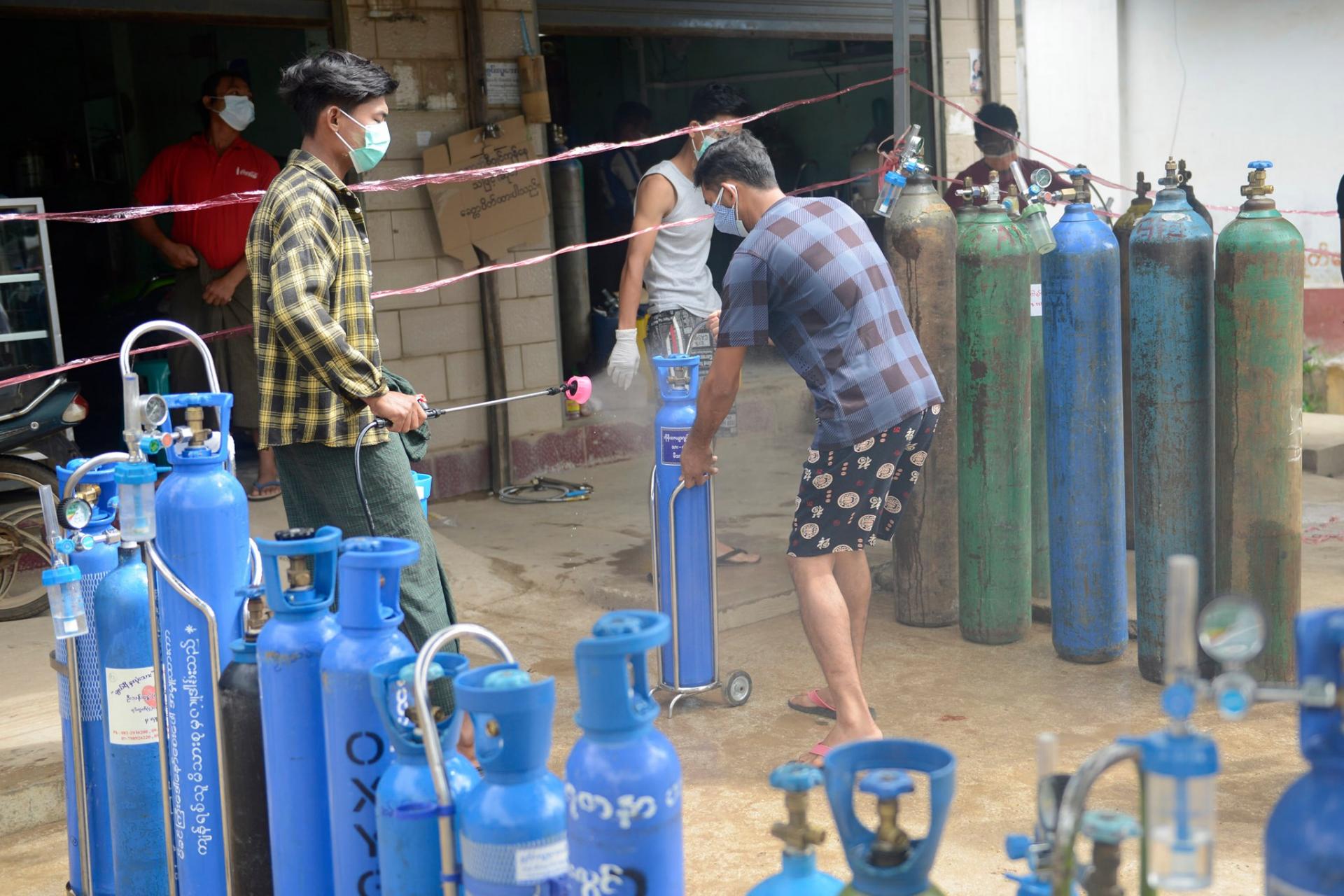
People come to refill oxygen tanks in Lashio. (Photo - Tun Nay Hlaing)
The high demand for oxygen
The most striking problem, at least up until now, is the lack of oxygen across the nation.
Kale Township in Sagaing Region is the prime example of such with locals and civil socities reporting that the demand for oxygen is only increasing by the day.
"We have to wait for the oxygen truck to arrive. There are so many that, even when the truck came, waited for their turn to refill but ran out," said a Kale local.
When the initial brunt of the third wave ravaged Kale and local oxygen supply cannot keep up, oxygen had to be supplied from areas as far as Yangon or Mandalay.
Since then, Kale locals had managed to pool together money and effort into obtaining an oxygen distiller, which is able to pump out 78 cyclinders with 40 litre capacity per day on July 9.
"The pressure was relieved somewhat but the demand is still there," said a local.
Since the beginning of the outbreak, Kale had reported high amount of deaths from Covid-19, saying that there are no streets without funeral homes within the town itself.
Since then, the need for oxygen had spread to places such as Yangon Region.
"We cannot get enough. We have been going around to fill up with the one cyclinder that remains. I feel sorry for the people," said a person from a volunteer group in Yangon.
This is a common occurrence in Yangon in recent days. There simply aren't enough volunteers, civil socities, well-wishers or donors to keep up with the demand.
"We used to have over 20 oxygen cylinders. We have zero now. We have rented them all out now. Some are past their due date but still keeping them so we have to ask for it back from them," said the volunteer.
Factories in South Dagon and Shwepyithar industrial zones had tried to fulfill the demands but had yet to be able to satisfy the needs.
"I've been waiting since morning. We can no longer fill up 40 litre cylinders. ONly 10 or 15 litre ones are okay. They say 40 litres will be allowed tomorrow. I have to take what I can get," said a person queuing up to refill oxygen in South Dagon industrial zone.
How much are they?
The sudden surge in demand and failure to keep up with such demand, means that prices have also skyrocketed and giving birth to a black market dealers.
A 40 litre oxygen cylinder went for around 180,000 Kyats while a 10 litre one used to cost around 80,000 Kyats.
But now, a 40 litre one clocks in at around 600,000 Kyats.
"Even at that price of 6 Lakhs, I cannot find any to purchase," said a person that tried but failed to purchase oxygen cylinders at more than triple their original prices.
"It is almost like buying smuggled items. We have to pay around 500,000 Kyats and even then, we have to buy one from here and another from there," said another volunteer in Yangon Region.
However, refill services provided by some had kept their greed in check, only charging around 5000 Kyats per refill.
"The prices remain the same. If I charge people more now, I am not fit to be called a human," said an in-charge from an oxygen factory in South Dagon industrial zone.
Amidst the problems of oxygen supply and demand, there also are cases of deaths because patients or family members underestimated the need for oxygen in emergency.
"The oxygen level should be at least 94. If it gets lower than that, it might be difficult to breathe but oxygen supply must still be administered," said another in-charge from a volunteer group.
Minister of Investment and Foreign Economic Relation Aung Naing Oo had said that due to the urgent demand, Oxygen Concentrators are now allowed to be imported without first needing FDA license.
"Due to rise in Covid-19 cases and large demand for oxygen, friends and business owners had asked me what will be done to facilitate import of Oxygen Concentrators. I would like to notify all here that respective ministries have done the following to facilitate import of Oxygen Concentrators. FDA approval will no longer be needed to import Oxygen Concentrators. There is also no need to apply for a import license at commerce/trade ministry. If imported product arrives here, 3 percent tax will not be needed to pay immediately but later as well as being allowed to immediately recieve the product," said Aung Naing Oo on Facebook.
Where is the answer?
According to an official at the MOHS, the need to facilitate more oxygen supply into the country is of utmost importance.
Covid-19's third wave had struck, killing more and more by the day across the whole country.
Over 6500 schools were reopened on June 1 for the 2021-2022 academic year but were forced to close, in a staggered fashion, in response to surging cases of Covid-19 which had seen several clusters at schools across Myanmar. Most have been temporarily shut down to the date of July 23, starting from July 9.
Treatment at hospitals have been prioritized to give attention to the elderly and those with severe symptoms such as oxygen levels lower than 90 at Yangon General Hospital, North Oakkalapa Hospital and Phaung Gyi. Those with suspect cases of Covid-19 or those with lower symptoms are advised to seek treatment at nearby public health clinics and other healthcare departments.
The MOHS had said that Yoma Yeikthar Covid-19 center had received 576 Covid positive patients with 1000 quarantined suspected cases. MCC Covid-19 center can only accept 250 positive patients. Inya Center in Mayangone Township can only accomodate up to around 500 patients.
The ministry had also said that Covid-19 tests can be taken at private hospitals with examples in Yangon Region being N Health, Pun Hlaing, Victoria, Aye, YAML Myanmar, Ar Yu, Bahosi, KBC, OSC and City Hospital.
Amidst the daunting task of attempting to control the Covid-19 outbreak, the matter of correctly introducing more life-saving oxygen supply into the country is the key puzzle onto of the question of how exactly to control the outbreak in the current situation.


